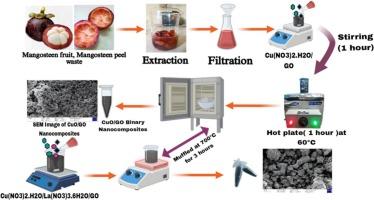氧化石墨烯修饰山竹CuO及CuO/La2O3超级电容器的研制
IF 4.6
3区 材料科学
Q2 MATERIALS SCIENCE, MULTIDISCIPLINARY
引用次数: 0
摘要
采用绿色介导的方法制备了以山竹为原料的CuO/GO和CuO/La2O3/GO二元和三元纳米复合材料。绿色化学的发展源于植物提取物作为天花板剂的天然产物及其形成NC的碳源。本研究以山竹果皮为原料,对其进行生物废弃物处理。山竹素是一类α-山竹素(山竹酮)、类黄酮和植物化学物质,还包括单宁和花青素,它们存在于果皮中,也被称为“水果女王”。通过XRD、FTIR、SEM、EDS、XPS和BET等手段对合成样品进行了结构、表面和元素组成的表征。制备了CuO/GO复合电极和CuO/La2O3/GO复合电极。采用循环伏安法(CV)、恒流充放电法(GCD)和电化学阻抗谱法(EIS)对超级电容器的电化学性能进行了评价。与二元复合材料相比,三元复合材料的超级电容电极在扫描速率为10 mV/s时的比电容值为447 F/g,在6 M KOH电解液中电流密度为1 a /g时的比电容值为472 F/g,取得了显著的比电容值。此外,它已经证明了96.2%的容量保持与卓越的循环稳定性高达5000 GCD循环。因此,CuO/La2O3/GO复合材料为未来高产电化学超级电容器的发展提供了一个有前途的选择。本文章由计算机程序翻译,如有差异,请以英文原文为准。

Development of GO-decorated CuO and CuO/La2O3 from Garcinia mangostana for supercapacitor application
The green-mediated approach is used to create the binary and ternary nanocomposites (NCs) of CuO/GO and CuO/La2O3/GO from Garcinia Mangostana. The development of green chemistry resulting from the natural products of plant extracts as ceiling agents and their source of carbon for the formation of NC. In this present work, we have selected the peels from mangosteen fruit as one of the biological waste products. Mangostins are a class of α-mangostin (xanthone), flavonoids and phytochemicals that also include tannins and anthocyanins, which are found in the pericarp, also known as the “Queen of Fruits”. The synthetic samples were characterised by structural, surface, and elemental composition analysis by XRD, FTIR, SEM, EDS, XPS, and BET studies. The CuO/GO and CuO/La2O3/GO composite electrodes were formed in a three-electrode arrangement. Cyclic voltammetry (CV), galvanostatic charge–discharge (GCD), and electrochemical impedance spectroscopy (EIS) studies were employed to evaluate the performance of supercapacitors through electrochemical analysis. The supercapacitor electrode of the ternary composite, with a specific capacitance value of 447 F/g at a scan rate of 10 mV/s and 472 F/g at a current density of 1 A/g in a 6 M KOH electrolyte, has achieved a remarkable specific capacitance value compared to the binary composite. Additionally, it has demonstrated 96.2 % capacity retention with exceptional cycling stability up to 5000 GCD cycles. As a result, CuO/La2O3/GO composite offers a promising alternative for the development of future high-yield electrochemical supercapacitors.
求助全文
通过发布文献求助,成功后即可免费获取论文全文。
去求助
来源期刊

Materials Science and Engineering: B
工程技术-材料科学:综合
CiteScore
5.60
自引率
2.80%
发文量
481
审稿时长
3.5 months
期刊介绍:
The journal provides an international medium for the publication of theoretical and experimental studies and reviews related to the electronic, electrochemical, ionic, magnetic, optical, and biosensing properties of solid state materials in bulk, thin film and particulate forms. Papers dealing with synthesis, processing, characterization, structure, physical properties and computational aspects of nano-crystalline, crystalline, amorphous and glassy forms of ceramics, semiconductors, layered insertion compounds, low-dimensional compounds and systems, fast-ion conductors, polymers and dielectrics are viewed as suitable for publication. Articles focused on nano-structured aspects of these advanced solid-state materials will also be considered suitable.
 求助内容:
求助内容: 应助结果提醒方式:
应助结果提醒方式:


